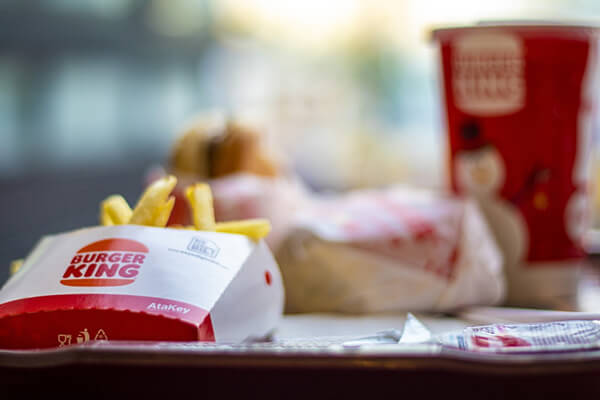The American fast-food brand Burger King has long reigned as the king of the global burger market, living up to its name. As a franchise offering a variety of menu items, Burger King boasts a long history. Let’s take a closer look at its journey and current status.
Born as Insta-Burger King in 1953

The first Burger King restaurant was established on July 28, 1953, in Jacksonville, Florida, USA. It was founded by Keith J. Cramer and his wife’s uncle, Matthew Burns. They acquired the rights to use a machine that could quickly cook hamburger patties and named their restaurant “Insta-Burger King” after it. Their business caught the attention of James McLamore and David Edgerton, who were searching for a promising franchise opportunity.
From Insta-Burger King to Burger King

McLamore and Edgerton persuaded the founders to sell the franchise rights. In 1954, just a year after the restaurant’s launch, they began opening additional locations and decided to drop “Insta” from the name, rebranding it simply as “Burger King.” By 1959, Insta-Burger King was struggling financially, and McLamore and Edgerton acquired the entire company, officially transforming it into Burger King.
Rapid Franchise Expansion

In its early days, Burger King rapidly increased its locations by selling franchise rights on a regional basis. While competitor McDonald’s maintained a strategy of purchasing real estate and leasing it to franchisees, Burger King’s contrasting approach allowed for quick expansion. When they acquired the entire franchise in 1959, there were only about 40 locations. This number quickly grew to 274 within eight years. In 1963, they opened their first overseas location in Puerto Rico.
Whopper: Burger King’s Signature Product

The Whopper is Burger King’s signature product. It was introduced in 1957, before Insta-Burger King faced bankruptcy, by James McLamore, not the founders. He created a large hamburger with a patty weighing 110 grams, naming it Whopper to signify its size. At the time, it was priced at 37 cents. Despite being more than twice the price of a typical hamburger, consumers eagerly paid for it, leading to its great success.
Strengthening Corporate Control Amid Rapid Growth

Burger King faced its first major crisis in the 1970s as several large franchise operators attempted to break away from the company. In 1978, Burger King recruited Donald N. Smith, a former McDonald’s executive, to regain control. Under his leadership, the company tightened franchise regulations, preventing local owners from launching independent chains and allowing corporate headquarters to terminate non-compliant franchisees. In 1979, Burger King also introduced a breakfast menu, which helped boost sales by 15% and allowed the company to overcome this period of instability.
Declining Performance and Sale to Private Equity Firms

Today, it’s widely recognized that fast food is not healthy, a perception that began spreading in the 1980s. As a result, sales for many fast-food franchises, including Burger King, sharply declined. In 1989, Burger King’s parent company sold the brand to the British corporation Grand Metropolitan. Later, Grand Metropolitan merged with Guinness to form Diageo, which controlled Burger King until 2002, when the company sold it to a private equity firm.
Stabilization After IPO on the New York Stock Exchange

After multiple sales to private equity firms, Burger King went through a turbulent period, with 13 different CEOs leading the company between its founding and 2013. The company finally stabilized in 2012 when 3G Capital, a private equity firm, purchased 29% of Burger King’s shares and took the company public on the New York Stock Exchange. Burger King then implemented significant structural reforms and aggressive marketing strategies to improve profitability. The company expanded its menu beyond burgers, adding salads and coffee, which helped bring operations back to stability.
The Pioneer of Sit-Down Fast-Food Restaurants

One of Burger King’s significant contributions to the global fast-food industry was the concept of sit-down dining. In the 1950s, most quick-service restaurants operated on a drive-thru basis. Burger King changed this by promoting an indoor seating area where customers could sit down and enjoy their meals. Additionally, the company marketed its quick service, promising to serve hot food within one minute of ordering without tipping. These factors contributed to its widespread appeal.
Flame-Grilled Patties: A Defining Characteristic

Burger King’s flame-grilled cooking method significantly influenced its early popularity. Since its founding, the company has used a system where burger patties pass through a gas grill on a conveyor belt, giving them a distinctive charred flavor. Unlike most fast-food chains that grill patties on flat-top griddles, Burger King’s method enhances the smoky taste of its burgers. Even today, this flame-grilling technique remains one of the brand’s most significant selling points.
Burger King Operates Under a Different Name in Australia

Although Burger King operates under its official name worldwide, Australia is an exception. When Burger King planned to enter the Australian market in 1971, it discovered that a local restaurant had already trademarked the name. As a result, the company chose a different brand name: Hungry Jack’s. The name was derived from Hungry Jack, a pancake brand owned by its parent company. Even today, all Burger King locations in Australia operate under the Hungry Jack’s name.














Most Commented